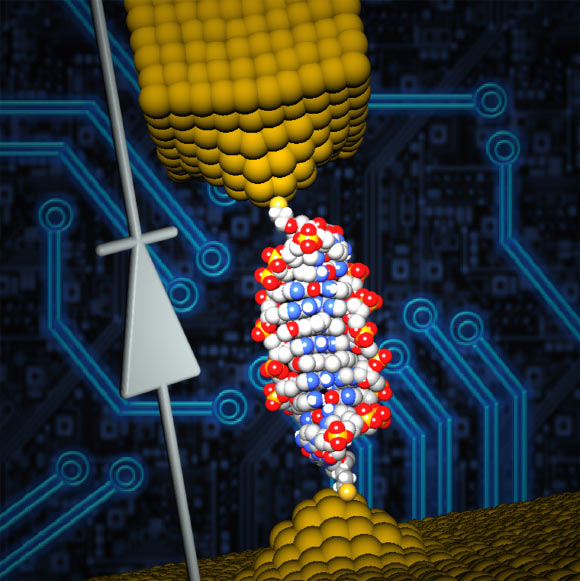A single-molecule diode, the world’s smallest, has been created by a team of researchers from Ben-Gurion University of the Negev and the University of Georgia. The team’s study was published online April 4 in the journal Nature Chemistry.

Scientists inserted a small molecule named coralyne into the DNA and were able to create a single-molecule diode, which can be used as an active element in future nanoscale circuits. Image credit: University of Georgia / Ben-Gurion University of the Negev.
“Creating and characterizing the world’s smallest diode is a significant milestone in the development of molecular electronic devices,” said lead co-author Dr. Yoni Dubi, from Ben-Gurion University of the Negev.
“It gives us new insights into the electronic transport mechanism.”
“For five decades we have been able to place more and more computing power onto smaller and smaller chips, but we are now pushing the physical limits of silicon,” added lead co-author Dr. Bingqian Xu, from the University of Georgia.
“If silicon-based chips become much smaller, their performance will become unstable and unpredictable.”
To find a solution to this challenge, the scientists turned to DNA.
“DNA’s predictability, diversity and programmability make it a leading candidate for the design of functional electronic devices using single molecules,” Dr. Xu said.
The team took a single DNA molecule constructed from 11 base pairs and connected it to an electronic circuit only a few nanometers in size.
When they measured the current through the molecule, it did not show any special behavior.
However, when layers of a molecule called ‘coralyne,’ were inserted between layers of DNA, the behavior of the circuit changed drastically.
The current jumped to 15 times larger negative vs. positive voltages — a necessary feature for a nano diode.
“This finding is quite counterintuitive because the molecular structure is still seemingly symmetrical after coralyne intercalation,” Dr. Xu said.
A theoretical model developed by the team indicated the diode-like behavior of DNA originates from the bias voltage-induced breaking of spatial symmetry inside the DNA molecule after the coralyne is inserted.
“Our discovery can lead to progress in the design and construction of nanoscale electronic elements that are at least 1,000 times smaller than current components,” Dr. Xu said.
The scientists plan to continue their work, with the goal of constructing additional molecular devices and enhancing the performance of the molecular diode.
_____
Cunlan Guo et al. Molecular rectifier composed of DNA with high rectification ratio enabled by intercalation. Nature Chemistry, published online April 4, 2016; doi: 10.1038/nchem.2480







